Strategic Decision Making: BNZ Case Analysis (Term 2, 2019)
VerifiedAdded on 2022/08/12
|11
|3652
|18
Case Study
AI Summary
This document presents a comprehensive case study analysis of the Bank of New Zealand (BNZ), focusing on its strategic decision-making processes, organizational functions, and approach to corporate governance. The analysis delves into BNZ's diverse financial services, including retail, business, and institutional banking, and examines how these functions contribute to its overall business strategy. The study explores BNZ's commitment to empowering its female employees and supporting women in the community through various informative programs and initiatives. Furthermore, the analysis critically evaluates BNZ's strategic actions, such as its focus on diversity, agribusiness, and digital investment, and assesses their impact on the bank's competitive advantage. The case study also highlights BNZ's adherence to corporate governance principles, including compliance with regulations like CRS, FATCA, and the Code of Banking Practice. Overall, the document provides insights into BNZ's operations, strategic decisions, and its commitment to both customer and community well-being, all while adhering to the case study brief requirements.

Strategic decision making
Paraphrase This Document
Need a fresh take? Get an instant paraphrase of this document with our AI Paraphraser
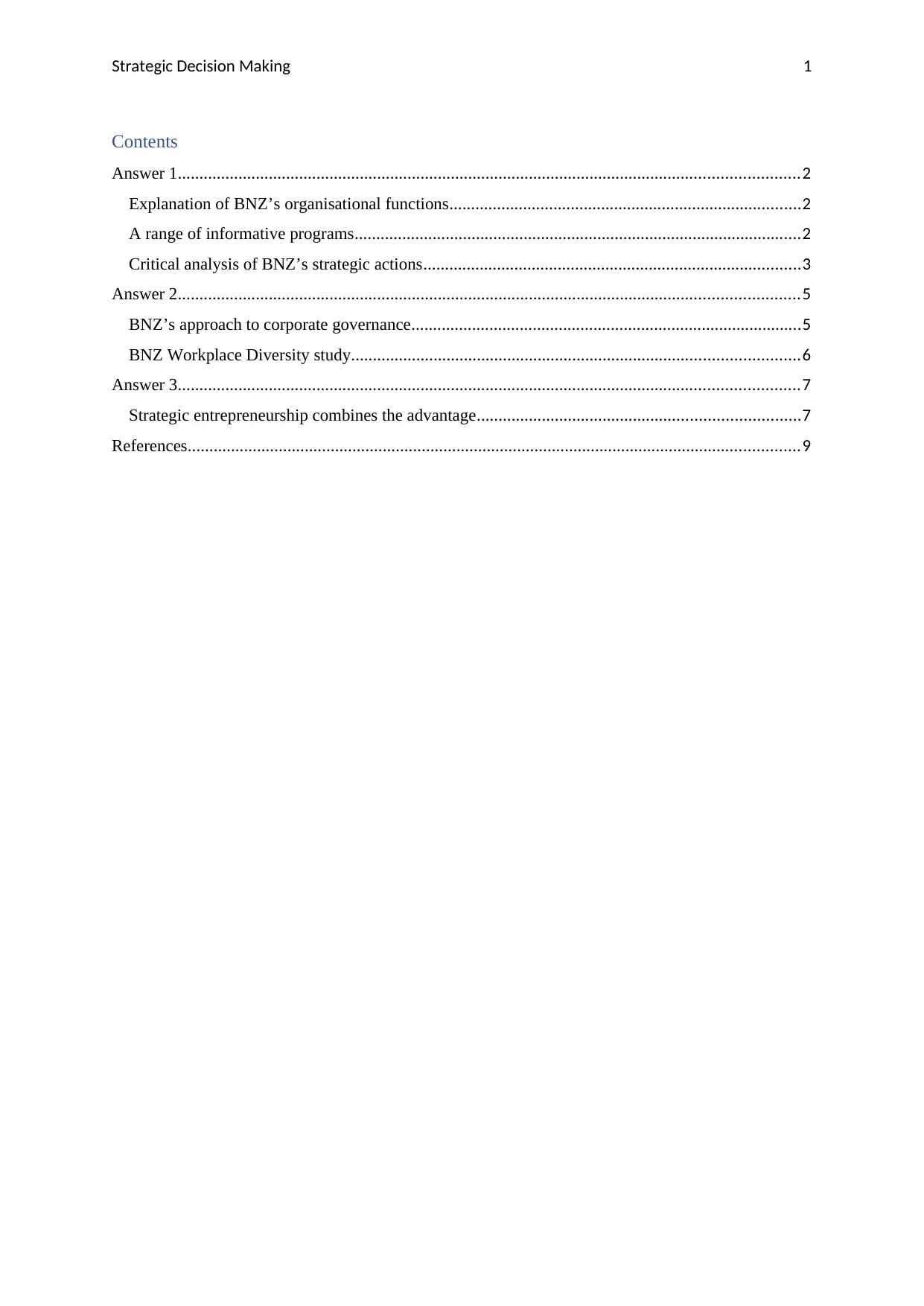
Strategic Decision Making 1
Contents
Answer 1...............................................................................................................................................2
Explanation of BNZ’s organisational functions.................................................................................2
A range of informative programs.......................................................................................................2
Critical analysis of BNZ’s strategic actions.......................................................................................3
Answer 2...............................................................................................................................................5
BNZ’s approach to corporate governance..........................................................................................5
BNZ Workplace Diversity study.......................................................................................................6
Answer 3...............................................................................................................................................7
Strategic entrepreneurship combines the advantage..........................................................................7
References.............................................................................................................................................9
Contents
Answer 1...............................................................................................................................................2
Explanation of BNZ’s organisational functions.................................................................................2
A range of informative programs.......................................................................................................2
Critical analysis of BNZ’s strategic actions.......................................................................................3
Answer 2...............................................................................................................................................5
BNZ’s approach to corporate governance..........................................................................................5
BNZ Workplace Diversity study.......................................................................................................6
Answer 3...............................................................................................................................................7
Strategic entrepreneurship combines the advantage..........................................................................7
References.............................................................................................................................................9
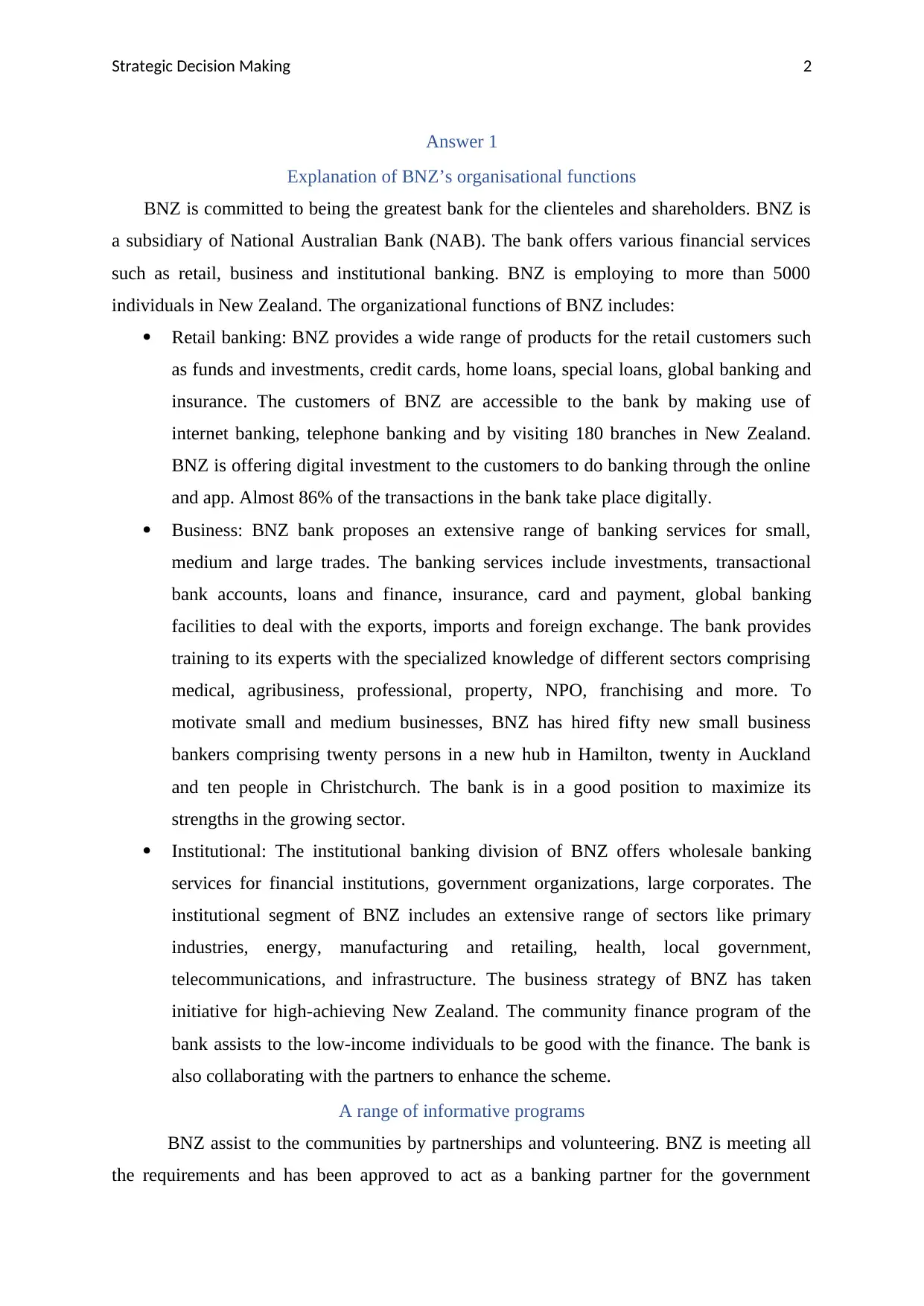
Strategic Decision Making 2
Answer 1
Explanation of BNZ’s organisational functions
BNZ is committed to being the greatest bank for the clienteles and shareholders. BNZ is
a subsidiary of National Australian Bank (NAB). The bank offers various financial services
such as retail, business and institutional banking. BNZ is employing to more than 5000
individuals in New Zealand. The organizational functions of BNZ includes:
Retail banking: BNZ provides a wide range of products for the retail customers such
as funds and investments, credit cards, home loans, special loans, global banking and
insurance. The customers of BNZ are accessible to the bank by making use of
internet banking, telephone banking and by visiting 180 branches in New Zealand.
BNZ is offering digital investment to the customers to do banking through the online
and app. Almost 86% of the transactions in the bank take place digitally.
Business: BNZ bank proposes an extensive range of banking services for small,
medium and large trades. The banking services include investments, transactional
bank accounts, loans and finance, insurance, card and payment, global banking
facilities to deal with the exports, imports and foreign exchange. The bank provides
training to its experts with the specialized knowledge of different sectors comprising
medical, agribusiness, professional, property, NPO, franchising and more. To
motivate small and medium businesses, BNZ has hired fifty new small business
bankers comprising twenty persons in a new hub in Hamilton, twenty in Auckland
and ten people in Christchurch. The bank is in a good position to maximize its
strengths in the growing sector.
Institutional: The institutional banking division of BNZ offers wholesale banking
services for financial institutions, government organizations, large corporates. The
institutional segment of BNZ includes an extensive range of sectors like primary
industries, energy, manufacturing and retailing, health, local government,
telecommunications, and infrastructure. The business strategy of BNZ has taken
initiative for high-achieving New Zealand. The community finance program of the
bank assists to the low-income individuals to be good with the finance. The bank is
also collaborating with the partners to enhance the scheme.
A range of informative programs
BNZ assist to the communities by partnerships and volunteering. BNZ is meeting all
the requirements and has been approved to act as a banking partner for the government
Answer 1
Explanation of BNZ’s organisational functions
BNZ is committed to being the greatest bank for the clienteles and shareholders. BNZ is
a subsidiary of National Australian Bank (NAB). The bank offers various financial services
such as retail, business and institutional banking. BNZ is employing to more than 5000
individuals in New Zealand. The organizational functions of BNZ includes:
Retail banking: BNZ provides a wide range of products for the retail customers such
as funds and investments, credit cards, home loans, special loans, global banking and
insurance. The customers of BNZ are accessible to the bank by making use of
internet banking, telephone banking and by visiting 180 branches in New Zealand.
BNZ is offering digital investment to the customers to do banking through the online
and app. Almost 86% of the transactions in the bank take place digitally.
Business: BNZ bank proposes an extensive range of banking services for small,
medium and large trades. The banking services include investments, transactional
bank accounts, loans and finance, insurance, card and payment, global banking
facilities to deal with the exports, imports and foreign exchange. The bank provides
training to its experts with the specialized knowledge of different sectors comprising
medical, agribusiness, professional, property, NPO, franchising and more. To
motivate small and medium businesses, BNZ has hired fifty new small business
bankers comprising twenty persons in a new hub in Hamilton, twenty in Auckland
and ten people in Christchurch. The bank is in a good position to maximize its
strengths in the growing sector.
Institutional: The institutional banking division of BNZ offers wholesale banking
services for financial institutions, government organizations, large corporates. The
institutional segment of BNZ includes an extensive range of sectors like primary
industries, energy, manufacturing and retailing, health, local government,
telecommunications, and infrastructure. The business strategy of BNZ has taken
initiative for high-achieving New Zealand. The community finance program of the
bank assists to the low-income individuals to be good with the finance. The bank is
also collaborating with the partners to enhance the scheme.
A range of informative programs
BNZ assist to the communities by partnerships and volunteering. BNZ is meeting all
the requirements and has been approved to act as a banking partner for the government
⊘ This is a preview!⊘
Do you want full access?
Subscribe today to unlock all pages.

Trusted by 1+ million students worldwide
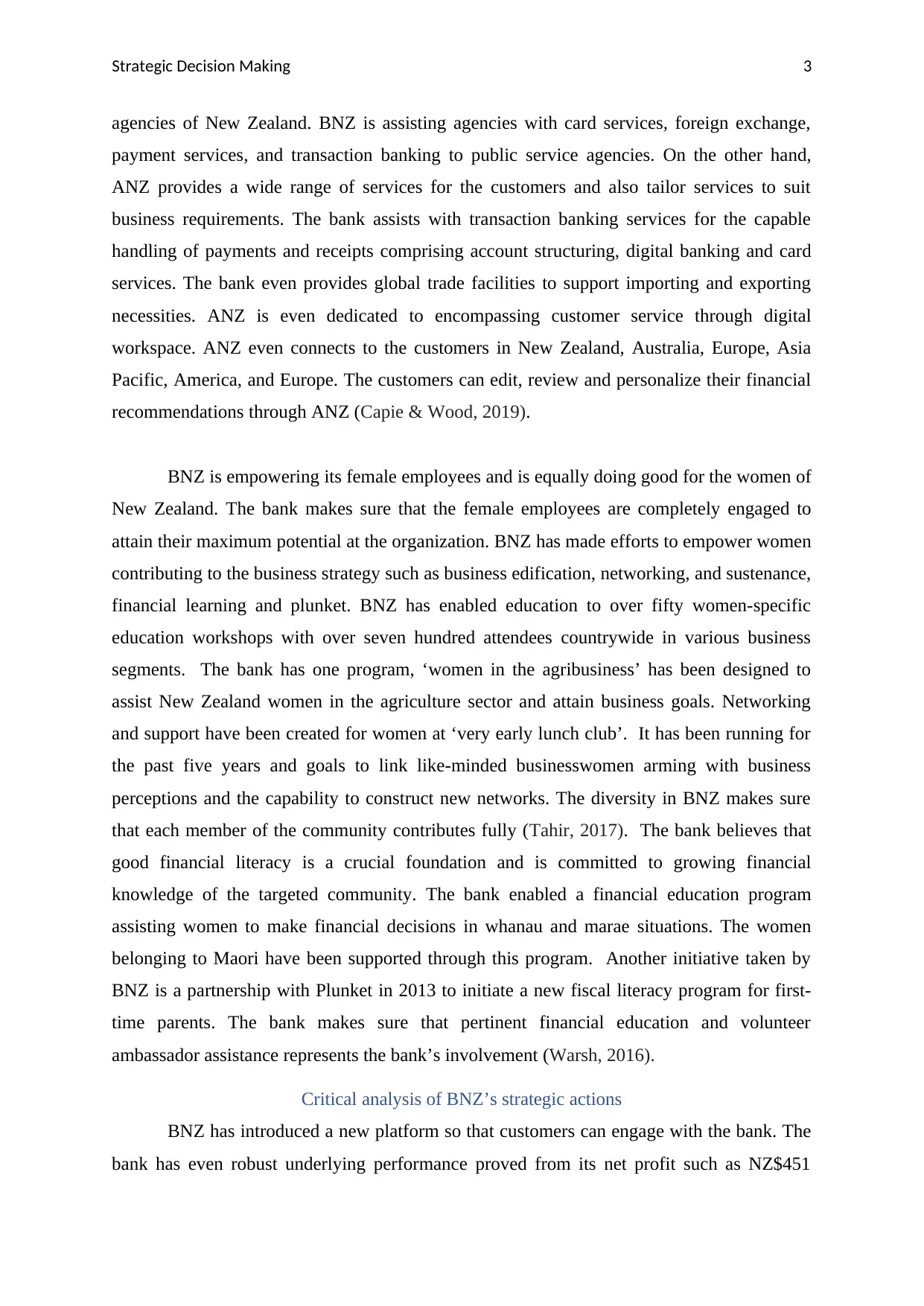
Strategic Decision Making 3
agencies of New Zealand. BNZ is assisting agencies with card services, foreign exchange,
payment services, and transaction banking to public service agencies. On the other hand,
ANZ provides a wide range of services for the customers and also tailor services to suit
business requirements. The bank assists with transaction banking services for the capable
handling of payments and receipts comprising account structuring, digital banking and card
services. The bank even provides global trade facilities to support importing and exporting
necessities. ANZ is even dedicated to encompassing customer service through digital
workspace. ANZ even connects to the customers in New Zealand, Australia, Europe, Asia
Pacific, America, and Europe. The customers can edit, review and personalize their financial
recommendations through ANZ (Capie & Wood, 2019).
BNZ is empowering its female employees and is equally doing good for the women of
New Zealand. The bank makes sure that the female employees are completely engaged to
attain their maximum potential at the organization. BNZ has made efforts to empower women
contributing to the business strategy such as business edification, networking, and sustenance,
financial learning and plunket. BNZ has enabled education to over fifty women-specific
education workshops with over seven hundred attendees countrywide in various business
segments. The bank has one program, ‘women in the agribusiness’ has been designed to
assist New Zealand women in the agriculture sector and attain business goals. Networking
and support have been created for women at ‘very early lunch club’. It has been running for
the past five years and goals to link like-minded businesswomen arming with business
perceptions and the capability to construct new networks. The diversity in BNZ makes sure
that each member of the community contributes fully (Tahir, 2017). The bank believes that
good financial literacy is a crucial foundation and is committed to growing financial
knowledge of the targeted community. The bank enabled a financial education program
assisting women to make financial decisions in whanau and marae situations. The women
belonging to Maori have been supported through this program. Another initiative taken by
BNZ is a partnership with Plunket in 2013 to initiate a new fiscal literacy program for first-
time parents. The bank makes sure that pertinent financial education and volunteer
ambassador assistance represents the bank’s involvement (Warsh, 2016).
Critical analysis of BNZ’s strategic actions
BNZ has introduced a new platform so that customers can engage with the bank. The
bank has even robust underlying performance proved from its net profit such as NZ$451
agencies of New Zealand. BNZ is assisting agencies with card services, foreign exchange,
payment services, and transaction banking to public service agencies. On the other hand,
ANZ provides a wide range of services for the customers and also tailor services to suit
business requirements. The bank assists with transaction banking services for the capable
handling of payments and receipts comprising account structuring, digital banking and card
services. The bank even provides global trade facilities to support importing and exporting
necessities. ANZ is even dedicated to encompassing customer service through digital
workspace. ANZ even connects to the customers in New Zealand, Australia, Europe, Asia
Pacific, America, and Europe. The customers can edit, review and personalize their financial
recommendations through ANZ (Capie & Wood, 2019).
BNZ is empowering its female employees and is equally doing good for the women of
New Zealand. The bank makes sure that the female employees are completely engaged to
attain their maximum potential at the organization. BNZ has made efforts to empower women
contributing to the business strategy such as business edification, networking, and sustenance,
financial learning and plunket. BNZ has enabled education to over fifty women-specific
education workshops with over seven hundred attendees countrywide in various business
segments. The bank has one program, ‘women in the agribusiness’ has been designed to
assist New Zealand women in the agriculture sector and attain business goals. Networking
and support have been created for women at ‘very early lunch club’. It has been running for
the past five years and goals to link like-minded businesswomen arming with business
perceptions and the capability to construct new networks. The diversity in BNZ makes sure
that each member of the community contributes fully (Tahir, 2017). The bank believes that
good financial literacy is a crucial foundation and is committed to growing financial
knowledge of the targeted community. The bank enabled a financial education program
assisting women to make financial decisions in whanau and marae situations. The women
belonging to Maori have been supported through this program. Another initiative taken by
BNZ is a partnership with Plunket in 2013 to initiate a new fiscal literacy program for first-
time parents. The bank makes sure that pertinent financial education and volunteer
ambassador assistance represents the bank’s involvement (Warsh, 2016).
Critical analysis of BNZ’s strategic actions
BNZ has introduced a new platform so that customers can engage with the bank. The
bank has even robust underlying performance proved from its net profit such as NZ$451
Paraphrase This Document
Need a fresh take? Get an instant paraphrase of this document with our AI Paraphraser
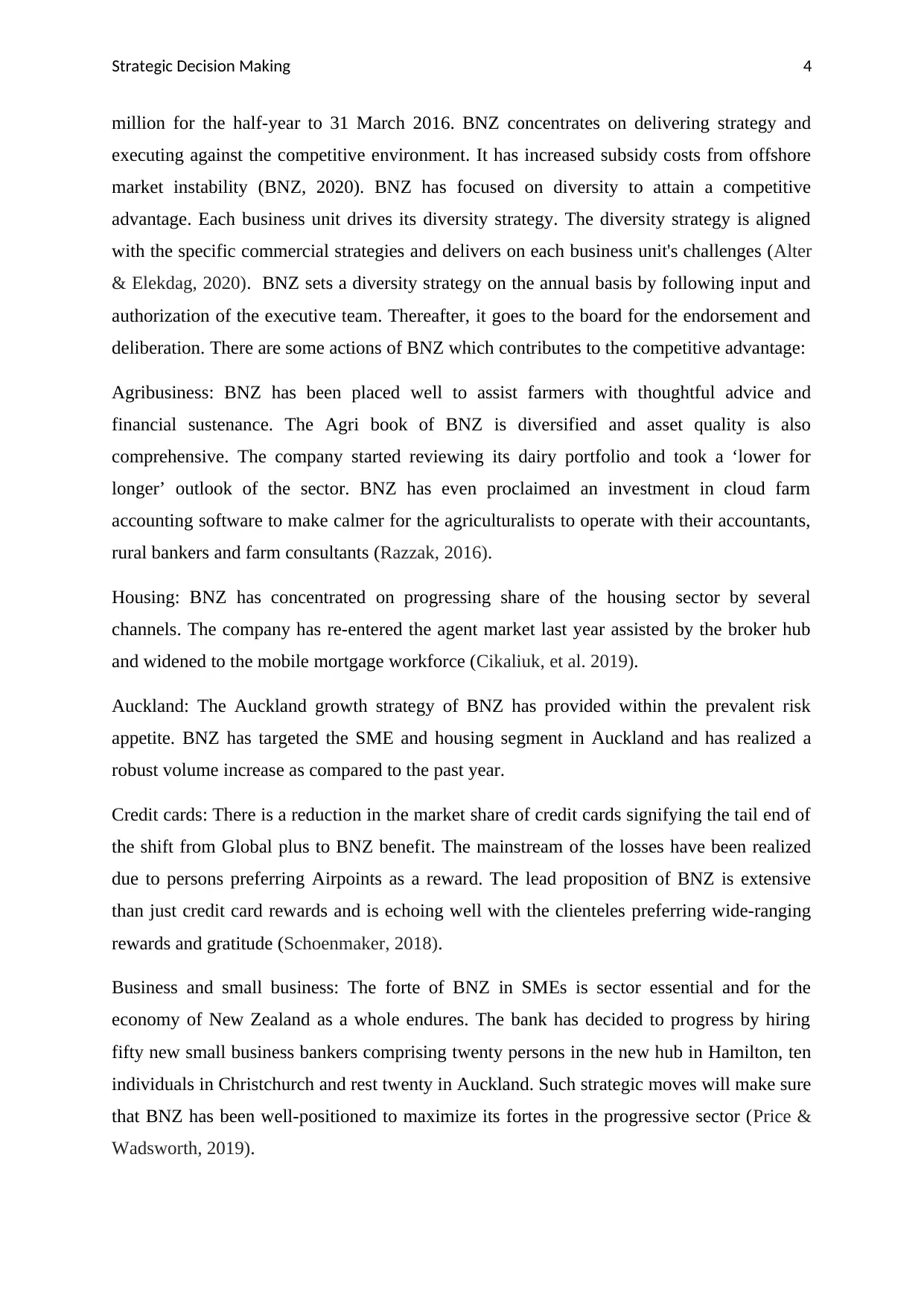
Strategic Decision Making 4
million for the half-year to 31 March 2016. BNZ concentrates on delivering strategy and
executing against the competitive environment. It has increased subsidy costs from offshore
market instability (BNZ, 2020). BNZ has focused on diversity to attain a competitive
advantage. Each business unit drives its diversity strategy. The diversity strategy is aligned
with the specific commercial strategies and delivers on each business unit's challenges (Alter
& Elekdag, 2020). BNZ sets a diversity strategy on the annual basis by following input and
authorization of the executive team. Thereafter, it goes to the board for the endorsement and
deliberation. There are some actions of BNZ which contributes to the competitive advantage:
Agribusiness: BNZ has been placed well to assist farmers with thoughtful advice and
financial sustenance. The Agri book of BNZ is diversified and asset quality is also
comprehensive. The company started reviewing its dairy portfolio and took a ‘lower for
longer’ outlook of the sector. BNZ has even proclaimed an investment in cloud farm
accounting software to make calmer for the agriculturalists to operate with their accountants,
rural bankers and farm consultants (Razzak, 2016).
Housing: BNZ has concentrated on progressing share of the housing sector by several
channels. The company has re-entered the agent market last year assisted by the broker hub
and widened to the mobile mortgage workforce (Cikaliuk, et al. 2019).
Auckland: The Auckland growth strategy of BNZ has provided within the prevalent risk
appetite. BNZ has targeted the SME and housing segment in Auckland and has realized a
robust volume increase as compared to the past year.
Credit cards: There is a reduction in the market share of credit cards signifying the tail end of
the shift from Global plus to BNZ benefit. The mainstream of the losses have been realized
due to persons preferring Airpoints as a reward. The lead proposition of BNZ is extensive
than just credit card rewards and is echoing well with the clienteles preferring wide-ranging
rewards and gratitude (Schoenmaker, 2018).
Business and small business: The forte of BNZ in SMEs is sector essential and for the
economy of New Zealand as a whole endures. The bank has decided to progress by hiring
fifty new small business bankers comprising twenty persons in the new hub in Hamilton, ten
individuals in Christchurch and rest twenty in Auckland. Such strategic moves will make sure
that BNZ has been well-positioned to maximize its fortes in the progressive sector (Price &
Wadsworth, 2019).
million for the half-year to 31 March 2016. BNZ concentrates on delivering strategy and
executing against the competitive environment. It has increased subsidy costs from offshore
market instability (BNZ, 2020). BNZ has focused on diversity to attain a competitive
advantage. Each business unit drives its diversity strategy. The diversity strategy is aligned
with the specific commercial strategies and delivers on each business unit's challenges (Alter
& Elekdag, 2020). BNZ sets a diversity strategy on the annual basis by following input and
authorization of the executive team. Thereafter, it goes to the board for the endorsement and
deliberation. There are some actions of BNZ which contributes to the competitive advantage:
Agribusiness: BNZ has been placed well to assist farmers with thoughtful advice and
financial sustenance. The Agri book of BNZ is diversified and asset quality is also
comprehensive. The company started reviewing its dairy portfolio and took a ‘lower for
longer’ outlook of the sector. BNZ has even proclaimed an investment in cloud farm
accounting software to make calmer for the agriculturalists to operate with their accountants,
rural bankers and farm consultants (Razzak, 2016).
Housing: BNZ has concentrated on progressing share of the housing sector by several
channels. The company has re-entered the agent market last year assisted by the broker hub
and widened to the mobile mortgage workforce (Cikaliuk, et al. 2019).
Auckland: The Auckland growth strategy of BNZ has provided within the prevalent risk
appetite. BNZ has targeted the SME and housing segment in Auckland and has realized a
robust volume increase as compared to the past year.
Credit cards: There is a reduction in the market share of credit cards signifying the tail end of
the shift from Global plus to BNZ benefit. The mainstream of the losses have been realized
due to persons preferring Airpoints as a reward. The lead proposition of BNZ is extensive
than just credit card rewards and is echoing well with the clienteles preferring wide-ranging
rewards and gratitude (Schoenmaker, 2018).
Business and small business: The forte of BNZ in SMEs is sector essential and for the
economy of New Zealand as a whole endures. The bank has decided to progress by hiring
fifty new small business bankers comprising twenty persons in the new hub in Hamilton, ten
individuals in Christchurch and rest twenty in Auckland. Such strategic moves will make sure
that BNZ has been well-positioned to maximize its fortes in the progressive sector (Price &
Wadsworth, 2019).
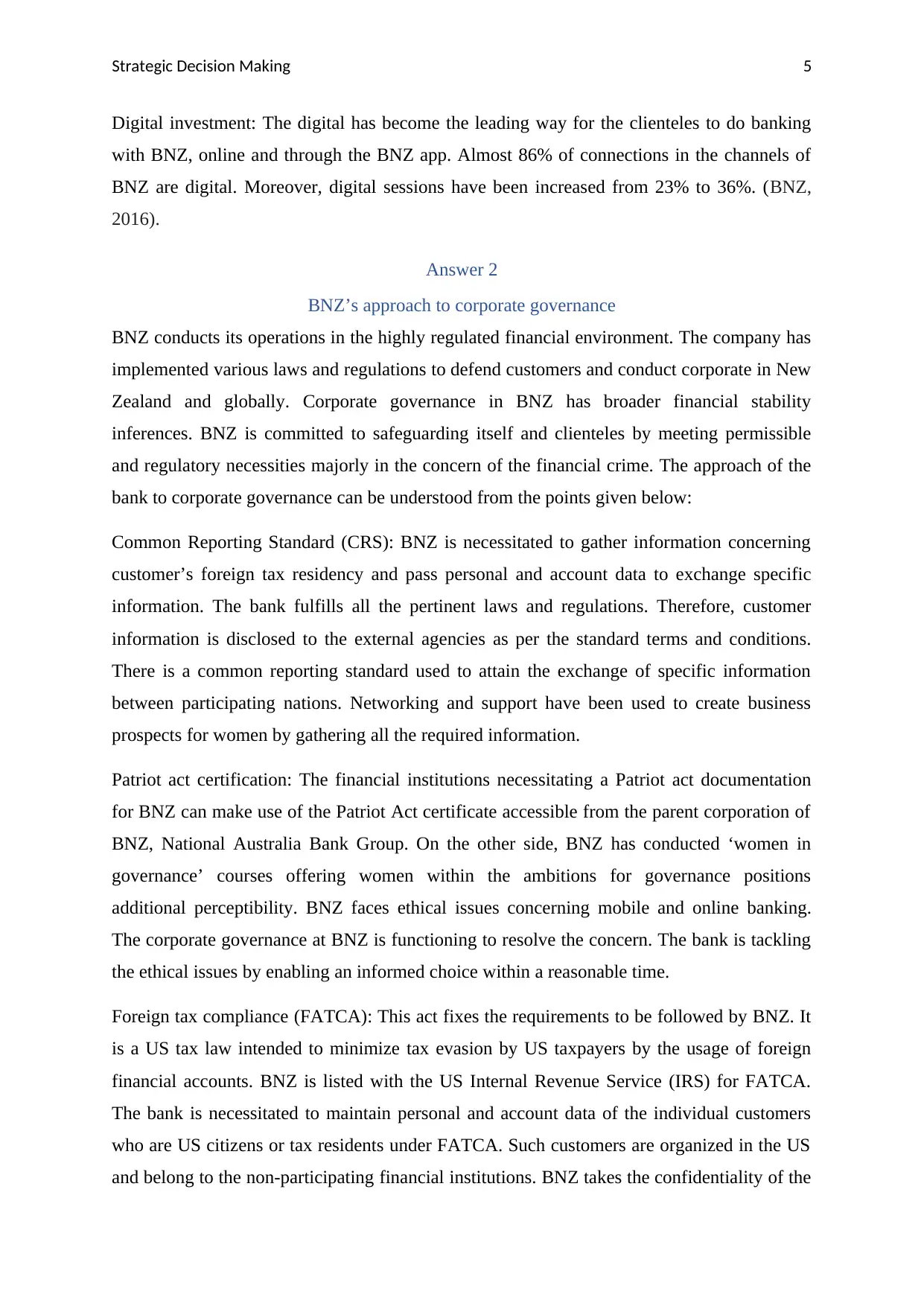
Strategic Decision Making 5
Digital investment: The digital has become the leading way for the clienteles to do banking
with BNZ, online and through the BNZ app. Almost 86% of connections in the channels of
BNZ are digital. Moreover, digital sessions have been increased from 23% to 36%. (BNZ,
2016).
Answer 2
BNZ’s approach to corporate governance
BNZ conducts its operations in the highly regulated financial environment. The company has
implemented various laws and regulations to defend customers and conduct corporate in New
Zealand and globally. Corporate governance in BNZ has broader financial stability
inferences. BNZ is committed to safeguarding itself and clienteles by meeting permissible
and regulatory necessities majorly in the concern of the financial crime. The approach of the
bank to corporate governance can be understood from the points given below:
Common Reporting Standard (CRS): BNZ is necessitated to gather information concerning
customer’s foreign tax residency and pass personal and account data to exchange specific
information. The bank fulfills all the pertinent laws and regulations. Therefore, customer
information is disclosed to the external agencies as per the standard terms and conditions.
There is a common reporting standard used to attain the exchange of specific information
between participating nations. Networking and support have been used to create business
prospects for women by gathering all the required information.
Patriot act certification: The financial institutions necessitating a Patriot act documentation
for BNZ can make use of the Patriot Act certificate accessible from the parent corporation of
BNZ, National Australia Bank Group. On the other side, BNZ has conducted ‘women in
governance’ courses offering women within the ambitions for governance positions
additional perceptibility. BNZ faces ethical issues concerning mobile and online banking.
The corporate governance at BNZ is functioning to resolve the concern. The bank is tackling
the ethical issues by enabling an informed choice within a reasonable time.
Foreign tax compliance (FATCA): This act fixes the requirements to be followed by BNZ. It
is a US tax law intended to minimize tax evasion by US taxpayers by the usage of foreign
financial accounts. BNZ is listed with the US Internal Revenue Service (IRS) for FATCA.
The bank is necessitated to maintain personal and account data of the individual customers
who are US citizens or tax residents under FATCA. Such customers are organized in the US
and belong to the non-participating financial institutions. BNZ takes the confidentiality of the
Digital investment: The digital has become the leading way for the clienteles to do banking
with BNZ, online and through the BNZ app. Almost 86% of connections in the channels of
BNZ are digital. Moreover, digital sessions have been increased from 23% to 36%. (BNZ,
2016).
Answer 2
BNZ’s approach to corporate governance
BNZ conducts its operations in the highly regulated financial environment. The company has
implemented various laws and regulations to defend customers and conduct corporate in New
Zealand and globally. Corporate governance in BNZ has broader financial stability
inferences. BNZ is committed to safeguarding itself and clienteles by meeting permissible
and regulatory necessities majorly in the concern of the financial crime. The approach of the
bank to corporate governance can be understood from the points given below:
Common Reporting Standard (CRS): BNZ is necessitated to gather information concerning
customer’s foreign tax residency and pass personal and account data to exchange specific
information. The bank fulfills all the pertinent laws and regulations. Therefore, customer
information is disclosed to the external agencies as per the standard terms and conditions.
There is a common reporting standard used to attain the exchange of specific information
between participating nations. Networking and support have been used to create business
prospects for women by gathering all the required information.
Patriot act certification: The financial institutions necessitating a Patriot act documentation
for BNZ can make use of the Patriot Act certificate accessible from the parent corporation of
BNZ, National Australia Bank Group. On the other side, BNZ has conducted ‘women in
governance’ courses offering women within the ambitions for governance positions
additional perceptibility. BNZ faces ethical issues concerning mobile and online banking.
The corporate governance at BNZ is functioning to resolve the concern. The bank is tackling
the ethical issues by enabling an informed choice within a reasonable time.
Foreign tax compliance (FATCA): This act fixes the requirements to be followed by BNZ. It
is a US tax law intended to minimize tax evasion by US taxpayers by the usage of foreign
financial accounts. BNZ is listed with the US Internal Revenue Service (IRS) for FATCA.
The bank is necessitated to maintain personal and account data of the individual customers
who are US citizens or tax residents under FATCA. Such customers are organized in the US
and belong to the non-participating financial institutions. BNZ takes the confidentiality of the
⊘ This is a preview!⊘
Do you want full access?
Subscribe today to unlock all pages.

Trusted by 1+ million students worldwide
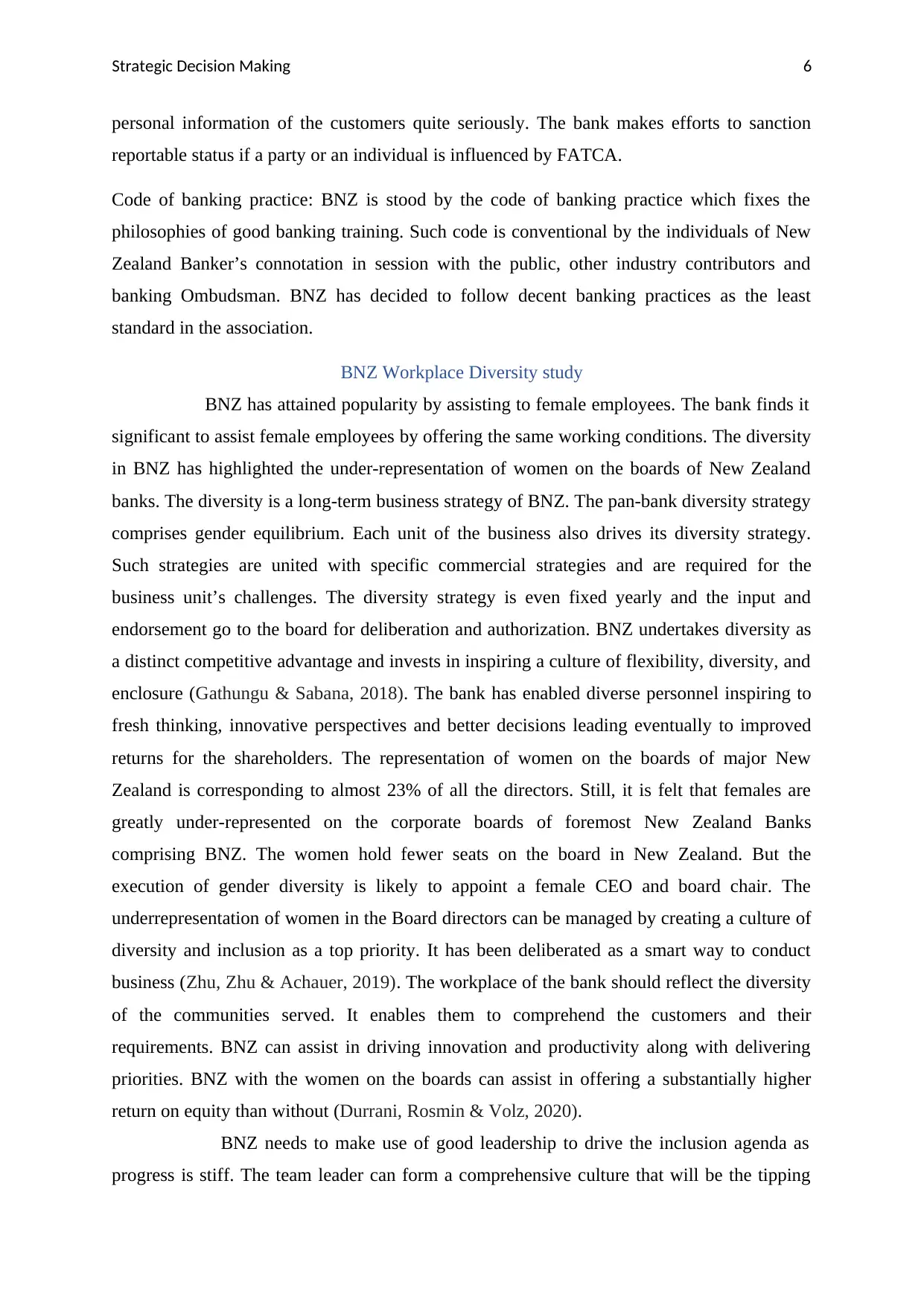
Strategic Decision Making 6
personal information of the customers quite seriously. The bank makes efforts to sanction
reportable status if a party or an individual is influenced by FATCA.
Code of banking practice: BNZ is stood by the code of banking practice which fixes the
philosophies of good banking training. Such code is conventional by the individuals of New
Zealand Banker’s connotation in session with the public, other industry contributors and
banking Ombudsman. BNZ has decided to follow decent banking practices as the least
standard in the association.
BNZ Workplace Diversity study
BNZ has attained popularity by assisting to female employees. The bank finds it
significant to assist female employees by offering the same working conditions. The diversity
in BNZ has highlighted the under-representation of women on the boards of New Zealand
banks. The diversity is a long-term business strategy of BNZ. The pan-bank diversity strategy
comprises gender equilibrium. Each unit of the business also drives its diversity strategy.
Such strategies are united with specific commercial strategies and are required for the
business unit’s challenges. The diversity strategy is even fixed yearly and the input and
endorsement go to the board for deliberation and authorization. BNZ undertakes diversity as
a distinct competitive advantage and invests in inspiring a culture of flexibility, diversity, and
enclosure (Gathungu & Sabana, 2018). The bank has enabled diverse personnel inspiring to
fresh thinking, innovative perspectives and better decisions leading eventually to improved
returns for the shareholders. The representation of women on the boards of major New
Zealand is corresponding to almost 23% of all the directors. Still, it is felt that females are
greatly under-represented on the corporate boards of foremost New Zealand Banks
comprising BNZ. The women hold fewer seats on the board in New Zealand. But the
execution of gender diversity is likely to appoint a female CEO and board chair. The
underrepresentation of women in the Board directors can be managed by creating a culture of
diversity and inclusion as a top priority. It has been deliberated as a smart way to conduct
business (Zhu, Zhu & Achauer, 2019). The workplace of the bank should reflect the diversity
of the communities served. It enables them to comprehend the customers and their
requirements. BNZ can assist in driving innovation and productivity along with delivering
priorities. BNZ with the women on the boards can assist in offering a substantially higher
return on equity than without (Durrani, Rosmin & Volz, 2020).
BNZ needs to make use of good leadership to drive the inclusion agenda as
progress is stiff. The team leader can form a comprehensive culture that will be the tipping
personal information of the customers quite seriously. The bank makes efforts to sanction
reportable status if a party or an individual is influenced by FATCA.
Code of banking practice: BNZ is stood by the code of banking practice which fixes the
philosophies of good banking training. Such code is conventional by the individuals of New
Zealand Banker’s connotation in session with the public, other industry contributors and
banking Ombudsman. BNZ has decided to follow decent banking practices as the least
standard in the association.
BNZ Workplace Diversity study
BNZ has attained popularity by assisting to female employees. The bank finds it
significant to assist female employees by offering the same working conditions. The diversity
in BNZ has highlighted the under-representation of women on the boards of New Zealand
banks. The diversity is a long-term business strategy of BNZ. The pan-bank diversity strategy
comprises gender equilibrium. Each unit of the business also drives its diversity strategy.
Such strategies are united with specific commercial strategies and are required for the
business unit’s challenges. The diversity strategy is even fixed yearly and the input and
endorsement go to the board for deliberation and authorization. BNZ undertakes diversity as
a distinct competitive advantage and invests in inspiring a culture of flexibility, diversity, and
enclosure (Gathungu & Sabana, 2018). The bank has enabled diverse personnel inspiring to
fresh thinking, innovative perspectives and better decisions leading eventually to improved
returns for the shareholders. The representation of women on the boards of major New
Zealand is corresponding to almost 23% of all the directors. Still, it is felt that females are
greatly under-represented on the corporate boards of foremost New Zealand Banks
comprising BNZ. The women hold fewer seats on the board in New Zealand. But the
execution of gender diversity is likely to appoint a female CEO and board chair. The
underrepresentation of women in the Board directors can be managed by creating a culture of
diversity and inclusion as a top priority. It has been deliberated as a smart way to conduct
business (Zhu, Zhu & Achauer, 2019). The workplace of the bank should reflect the diversity
of the communities served. It enables them to comprehend the customers and their
requirements. BNZ can assist in driving innovation and productivity along with delivering
priorities. BNZ with the women on the boards can assist in offering a substantially higher
return on equity than without (Durrani, Rosmin & Volz, 2020).
BNZ needs to make use of good leadership to drive the inclusion agenda as
progress is stiff. The team leader can form a comprehensive culture that will be the tipping
Paraphrase This Document
Need a fresh take? Get an instant paraphrase of this document with our AI Paraphraser
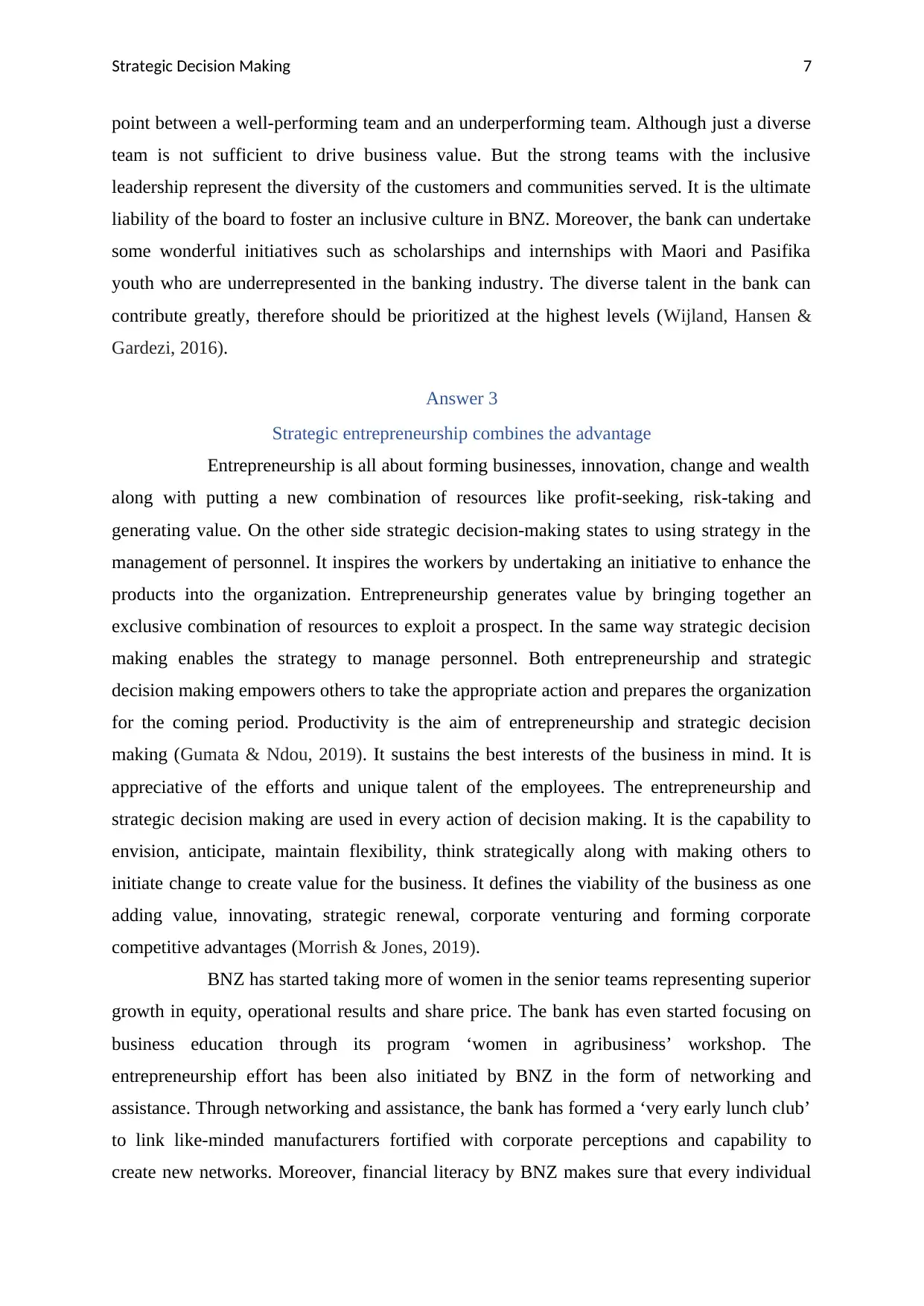
Strategic Decision Making 7
point between a well-performing team and an underperforming team. Although just a diverse
team is not sufficient to drive business value. But the strong teams with the inclusive
leadership represent the diversity of the customers and communities served. It is the ultimate
liability of the board to foster an inclusive culture in BNZ. Moreover, the bank can undertake
some wonderful initiatives such as scholarships and internships with Maori and Pasifika
youth who are underrepresented in the banking industry. The diverse talent in the bank can
contribute greatly, therefore should be prioritized at the highest levels (Wijland, Hansen &
Gardezi, 2016).
Answer 3
Strategic entrepreneurship combines the advantage
Entrepreneurship is all about forming businesses, innovation, change and wealth
along with putting a new combination of resources like profit-seeking, risk-taking and
generating value. On the other side strategic decision-making states to using strategy in the
management of personnel. It inspires the workers by undertaking an initiative to enhance the
products into the organization. Entrepreneurship generates value by bringing together an
exclusive combination of resources to exploit a prospect. In the same way strategic decision
making enables the strategy to manage personnel. Both entrepreneurship and strategic
decision making empowers others to take the appropriate action and prepares the organization
for the coming period. Productivity is the aim of entrepreneurship and strategic decision
making (Gumata & Ndou, 2019). It sustains the best interests of the business in mind. It is
appreciative of the efforts and unique talent of the employees. The entrepreneurship and
strategic decision making are used in every action of decision making. It is the capability to
envision, anticipate, maintain flexibility, think strategically along with making others to
initiate change to create value for the business. It defines the viability of the business as one
adding value, innovating, strategic renewal, corporate venturing and forming corporate
competitive advantages (Morrish & Jones, 2019).
BNZ has started taking more of women in the senior teams representing superior
growth in equity, operational results and share price. The bank has even started focusing on
business education through its program ‘women in agribusiness’ workshop. The
entrepreneurship effort has been also initiated by BNZ in the form of networking and
assistance. Through networking and assistance, the bank has formed a ‘very early lunch club’
to link like-minded manufacturers fortified with corporate perceptions and capability to
create new networks. Moreover, financial literacy by BNZ makes sure that every individual
point between a well-performing team and an underperforming team. Although just a diverse
team is not sufficient to drive business value. But the strong teams with the inclusive
leadership represent the diversity of the customers and communities served. It is the ultimate
liability of the board to foster an inclusive culture in BNZ. Moreover, the bank can undertake
some wonderful initiatives such as scholarships and internships with Maori and Pasifika
youth who are underrepresented in the banking industry. The diverse talent in the bank can
contribute greatly, therefore should be prioritized at the highest levels (Wijland, Hansen &
Gardezi, 2016).
Answer 3
Strategic entrepreneurship combines the advantage
Entrepreneurship is all about forming businesses, innovation, change and wealth
along with putting a new combination of resources like profit-seeking, risk-taking and
generating value. On the other side strategic decision-making states to using strategy in the
management of personnel. It inspires the workers by undertaking an initiative to enhance the
products into the organization. Entrepreneurship generates value by bringing together an
exclusive combination of resources to exploit a prospect. In the same way strategic decision
making enables the strategy to manage personnel. Both entrepreneurship and strategic
decision making empowers others to take the appropriate action and prepares the organization
for the coming period. Productivity is the aim of entrepreneurship and strategic decision
making (Gumata & Ndou, 2019). It sustains the best interests of the business in mind. It is
appreciative of the efforts and unique talent of the employees. The entrepreneurship and
strategic decision making are used in every action of decision making. It is the capability to
envision, anticipate, maintain flexibility, think strategically along with making others to
initiate change to create value for the business. It defines the viability of the business as one
adding value, innovating, strategic renewal, corporate venturing and forming corporate
competitive advantages (Morrish & Jones, 2019).
BNZ has started taking more of women in the senior teams representing superior
growth in equity, operational results and share price. The bank has even started focusing on
business education through its program ‘women in agribusiness’ workshop. The
entrepreneurship effort has been also initiated by BNZ in the form of networking and
assistance. Through networking and assistance, the bank has formed a ‘very early lunch club’
to link like-minded manufacturers fortified with corporate perceptions and capability to
create new networks. Moreover, financial literacy by BNZ makes sure that every individual
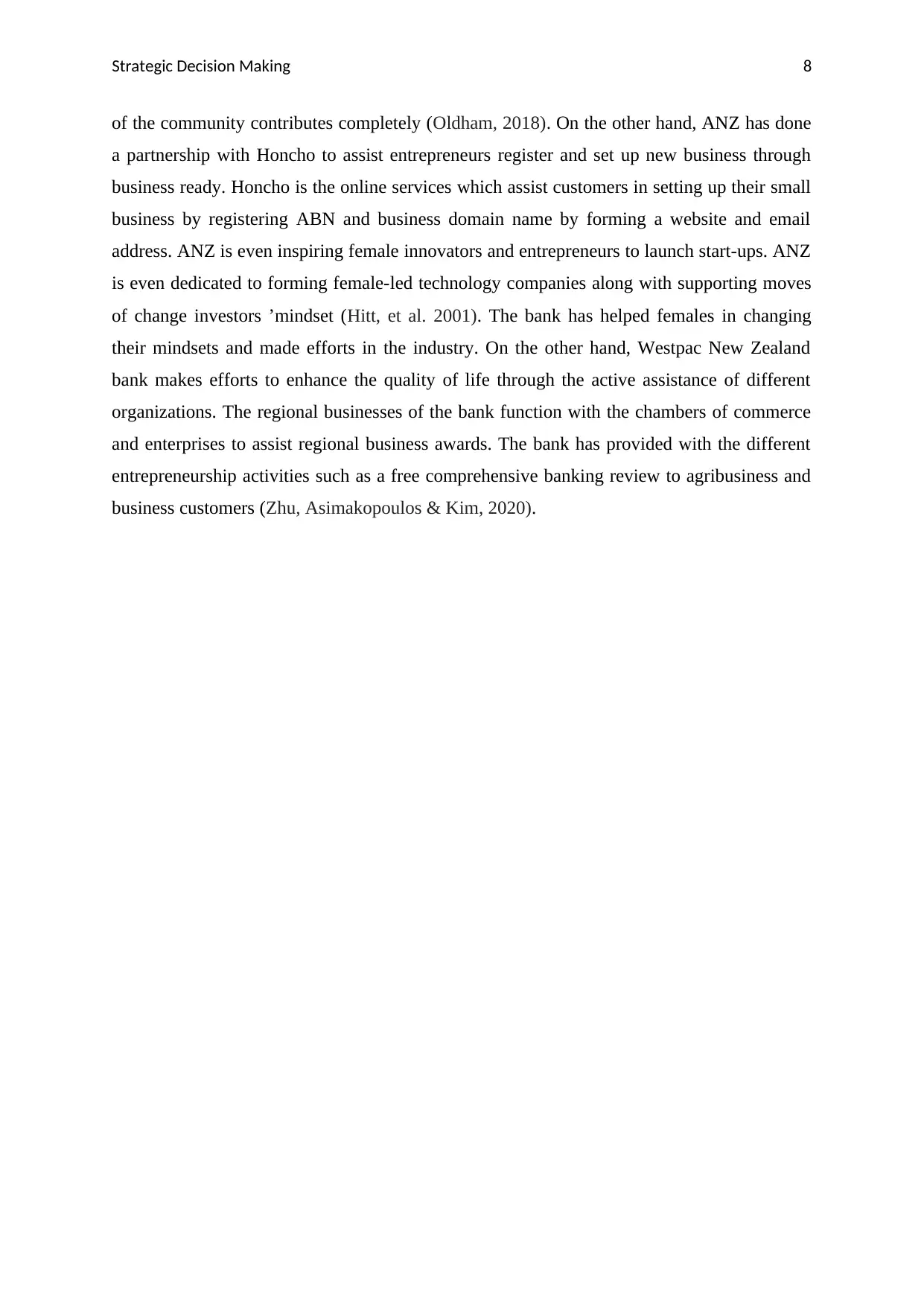
Strategic Decision Making 8
of the community contributes completely (Oldham, 2018). On the other hand, ANZ has done
a partnership with Honcho to assist entrepreneurs register and set up new business through
business ready. Honcho is the online services which assist customers in setting up their small
business by registering ABN and business domain name by forming a website and email
address. ANZ is even inspiring female innovators and entrepreneurs to launch start-ups. ANZ
is even dedicated to forming female-led technology companies along with supporting moves
of change investors ’mindset (Hitt, et al. 2001). The bank has helped females in changing
their mindsets and made efforts in the industry. On the other hand, Westpac New Zealand
bank makes efforts to enhance the quality of life through the active assistance of different
organizations. The regional businesses of the bank function with the chambers of commerce
and enterprises to assist regional business awards. The bank has provided with the different
entrepreneurship activities such as a free comprehensive banking review to agribusiness and
business customers (Zhu, Asimakopoulos & Kim, 2020).
of the community contributes completely (Oldham, 2018). On the other hand, ANZ has done
a partnership with Honcho to assist entrepreneurs register and set up new business through
business ready. Honcho is the online services which assist customers in setting up their small
business by registering ABN and business domain name by forming a website and email
address. ANZ is even inspiring female innovators and entrepreneurs to launch start-ups. ANZ
is even dedicated to forming female-led technology companies along with supporting moves
of change investors ’mindset (Hitt, et al. 2001). The bank has helped females in changing
their mindsets and made efforts in the industry. On the other hand, Westpac New Zealand
bank makes efforts to enhance the quality of life through the active assistance of different
organizations. The regional businesses of the bank function with the chambers of commerce
and enterprises to assist regional business awards. The bank has provided with the different
entrepreneurship activities such as a free comprehensive banking review to agribusiness and
business customers (Zhu, Asimakopoulos & Kim, 2020).
⊘ This is a preview!⊘
Do you want full access?
Subscribe today to unlock all pages.

Trusted by 1+ million students worldwide
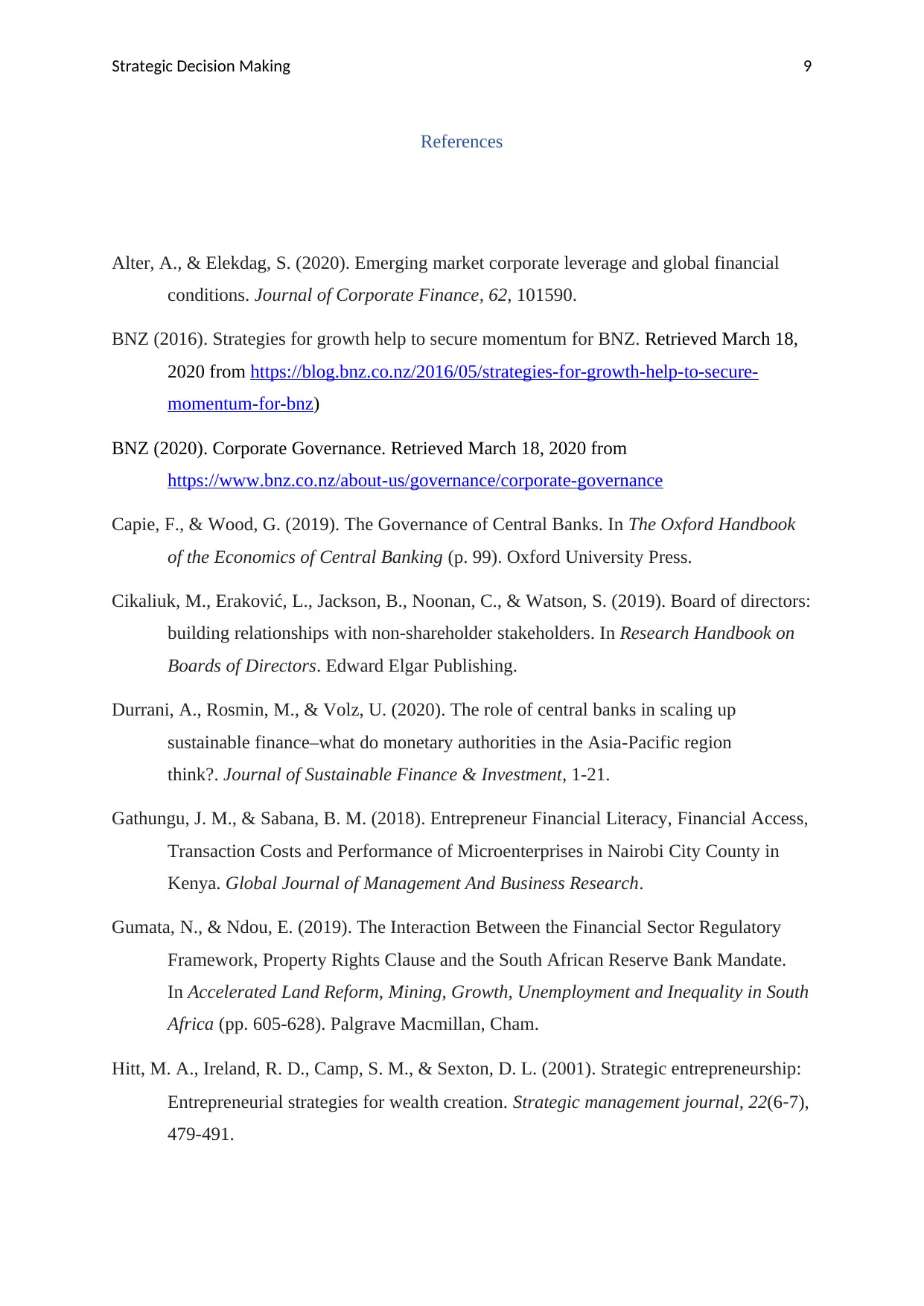
Strategic Decision Making 9
References
Alter, A., & Elekdag, S. (2020). Emerging market corporate leverage and global financial
conditions. Journal of Corporate Finance, 62, 101590.
BNZ (2016). Strategies for growth help to secure momentum for BNZ. Retrieved March 18,
2020 from https://blog.bnz.co.nz/2016/05/strategies-for-growth-help-to-secure-
momentum-for-bnz)
BNZ (2020). Corporate Governance. Retrieved March 18, 2020 from
https://www.bnz.co.nz/about-us/governance/corporate-governance
Capie, F., & Wood, G. (2019). The Governance of Central Banks. In The Oxford Handbook
of the Economics of Central Banking (p. 99). Oxford University Press.
Cikaliuk, M., Eraković, L., Jackson, B., Noonan, C., & Watson, S. (2019). Board of directors:
building relationships with non-shareholder stakeholders. In Research Handbook on
Boards of Directors. Edward Elgar Publishing.
Durrani, A., Rosmin, M., & Volz, U. (2020). The role of central banks in scaling up
sustainable finance–what do monetary authorities in the Asia-Pacific region
think?. Journal of Sustainable Finance & Investment, 1-21.
Gathungu, J. M., & Sabana, B. M. (2018). Entrepreneur Financial Literacy, Financial Access,
Transaction Costs and Performance of Microenterprises in Nairobi City County in
Kenya. Global Journal of Management And Business Research.
Gumata, N., & Ndou, E. (2019). The Interaction Between the Financial Sector Regulatory
Framework, Property Rights Clause and the South African Reserve Bank Mandate.
In Accelerated Land Reform, Mining, Growth, Unemployment and Inequality in South
Africa (pp. 605-628). Palgrave Macmillan, Cham.
Hitt, M. A., Ireland, R. D., Camp, S. M., & Sexton, D. L. (2001). Strategic entrepreneurship:
Entrepreneurial strategies for wealth creation. Strategic management journal, 22(6‐7),
479-491.
References
Alter, A., & Elekdag, S. (2020). Emerging market corporate leverage and global financial
conditions. Journal of Corporate Finance, 62, 101590.
BNZ (2016). Strategies for growth help to secure momentum for BNZ. Retrieved March 18,
2020 from https://blog.bnz.co.nz/2016/05/strategies-for-growth-help-to-secure-
momentum-for-bnz)
BNZ (2020). Corporate Governance. Retrieved March 18, 2020 from
https://www.bnz.co.nz/about-us/governance/corporate-governance
Capie, F., & Wood, G. (2019). The Governance of Central Banks. In The Oxford Handbook
of the Economics of Central Banking (p. 99). Oxford University Press.
Cikaliuk, M., Eraković, L., Jackson, B., Noonan, C., & Watson, S. (2019). Board of directors:
building relationships with non-shareholder stakeholders. In Research Handbook on
Boards of Directors. Edward Elgar Publishing.
Durrani, A., Rosmin, M., & Volz, U. (2020). The role of central banks in scaling up
sustainable finance–what do monetary authorities in the Asia-Pacific region
think?. Journal of Sustainable Finance & Investment, 1-21.
Gathungu, J. M., & Sabana, B. M. (2018). Entrepreneur Financial Literacy, Financial Access,
Transaction Costs and Performance of Microenterprises in Nairobi City County in
Kenya. Global Journal of Management And Business Research.
Gumata, N., & Ndou, E. (2019). The Interaction Between the Financial Sector Regulatory
Framework, Property Rights Clause and the South African Reserve Bank Mandate.
In Accelerated Land Reform, Mining, Growth, Unemployment and Inequality in South
Africa (pp. 605-628). Palgrave Macmillan, Cham.
Hitt, M. A., Ireland, R. D., Camp, S. M., & Sexton, D. L. (2001). Strategic entrepreneurship:
Entrepreneurial strategies for wealth creation. Strategic management journal, 22(6‐7),
479-491.
Paraphrase This Document
Need a fresh take? Get an instant paraphrase of this document with our AI Paraphraser
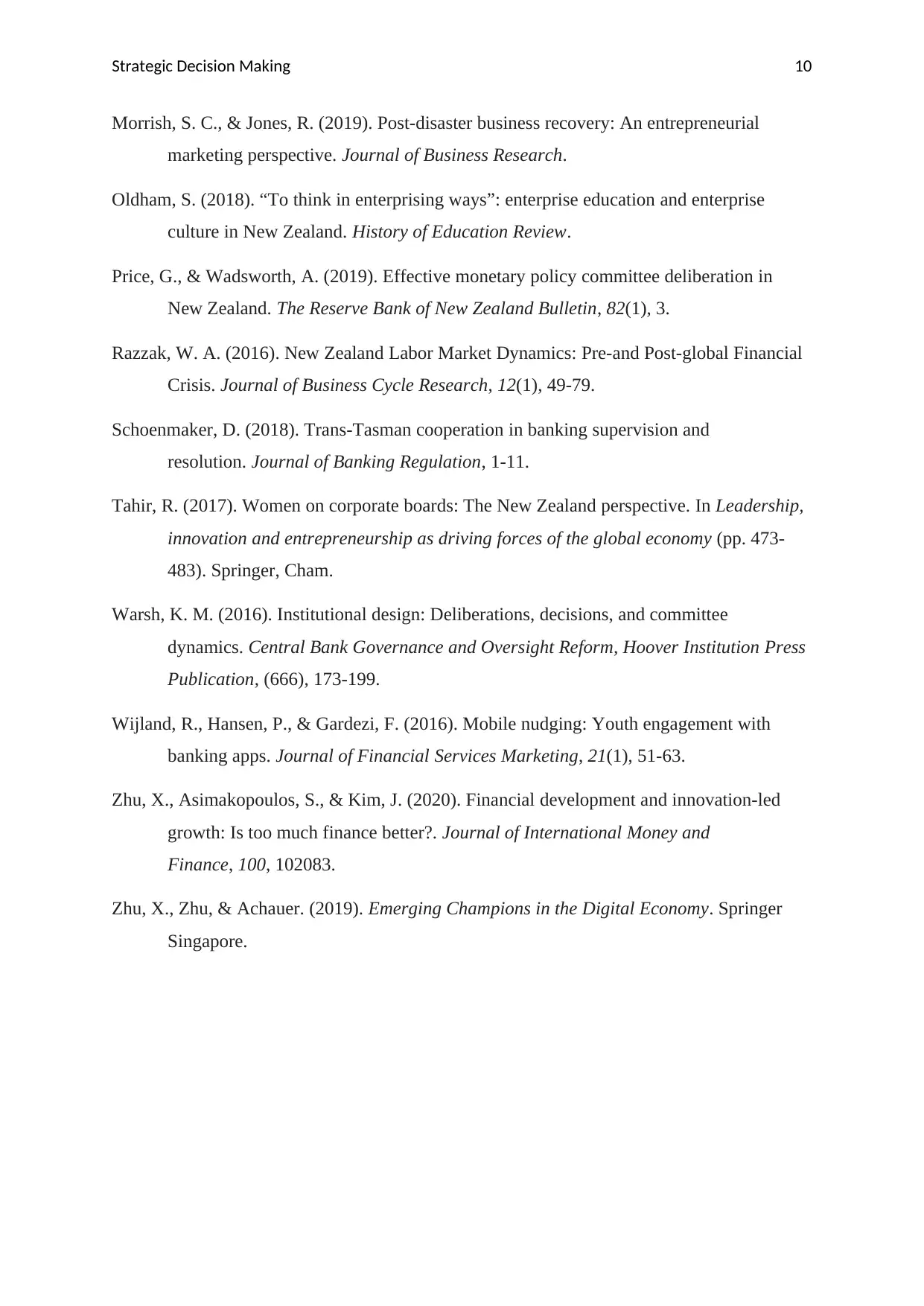
Strategic Decision Making 10
Morrish, S. C., & Jones, R. (2019). Post-disaster business recovery: An entrepreneurial
marketing perspective. Journal of Business Research.
Oldham, S. (2018). “To think in enterprising ways”: enterprise education and enterprise
culture in New Zealand. History of Education Review.
Price, G., & Wadsworth, A. (2019). Effective monetary policy committee deliberation in
New Zealand. The Reserve Bank of New Zealand Bulletin, 82(1), 3.
Razzak, W. A. (2016). New Zealand Labor Market Dynamics: Pre-and Post-global Financial
Crisis. Journal of Business Cycle Research, 12(1), 49-79.
Schoenmaker, D. (2018). Trans-Tasman cooperation in banking supervision and
resolution. Journal of Banking Regulation, 1-11.
Tahir, R. (2017). Women on corporate boards: The New Zealand perspective. In Leadership,
innovation and entrepreneurship as driving forces of the global economy (pp. 473-
483). Springer, Cham.
Warsh, K. M. (2016). Institutional design: Deliberations, decisions, and committee
dynamics. Central Bank Governance and Oversight Reform, Hoover Institution Press
Publication, (666), 173-199.
Wijland, R., Hansen, P., & Gardezi, F. (2016). Mobile nudging: Youth engagement with
banking apps. Journal of Financial Services Marketing, 21(1), 51-63.
Zhu, X., Asimakopoulos, S., & Kim, J. (2020). Financial development and innovation-led
growth: Is too much finance better?. Journal of International Money and
Finance, 100, 102083.
Zhu, X., Zhu, & Achauer. (2019). Emerging Champions in the Digital Economy. Springer
Singapore.
Morrish, S. C., & Jones, R. (2019). Post-disaster business recovery: An entrepreneurial
marketing perspective. Journal of Business Research.
Oldham, S. (2018). “To think in enterprising ways”: enterprise education and enterprise
culture in New Zealand. History of Education Review.
Price, G., & Wadsworth, A. (2019). Effective monetary policy committee deliberation in
New Zealand. The Reserve Bank of New Zealand Bulletin, 82(1), 3.
Razzak, W. A. (2016). New Zealand Labor Market Dynamics: Pre-and Post-global Financial
Crisis. Journal of Business Cycle Research, 12(1), 49-79.
Schoenmaker, D. (2018). Trans-Tasman cooperation in banking supervision and
resolution. Journal of Banking Regulation, 1-11.
Tahir, R. (2017). Women on corporate boards: The New Zealand perspective. In Leadership,
innovation and entrepreneurship as driving forces of the global economy (pp. 473-
483). Springer, Cham.
Warsh, K. M. (2016). Institutional design: Deliberations, decisions, and committee
dynamics. Central Bank Governance and Oversight Reform, Hoover Institution Press
Publication, (666), 173-199.
Wijland, R., Hansen, P., & Gardezi, F. (2016). Mobile nudging: Youth engagement with
banking apps. Journal of Financial Services Marketing, 21(1), 51-63.
Zhu, X., Asimakopoulos, S., & Kim, J. (2020). Financial development and innovation-led
growth: Is too much finance better?. Journal of International Money and
Finance, 100, 102083.
Zhu, X., Zhu, & Achauer. (2019). Emerging Champions in the Digital Economy. Springer
Singapore.
1 out of 11
Related Documents
Your All-in-One AI-Powered Toolkit for Academic Success.
+13062052269
info@desklib.com
Available 24*7 on WhatsApp / Email
![[object Object]](/_next/static/media/star-bottom.7253800d.svg)
Unlock your academic potential
Copyright © 2020–2025 A2Z Services. All Rights Reserved. Developed and managed by ZUCOL.





